Stars shine in different colors because of their surface temperatures. Cooler stars (around 3,000°C) appear red, while hotter stars (up to 40,000°C) burn blue, with orange, yellow, and white stars falling in between. Your eyes typically perceive most stars as white because faint starlight activates only rod cells, not color-sensitive cones. Astronomers classify stars using the OBAFGKM sequence from hottest to coolest. The night sky reveals these spectacular hues when you know where to look.
The Temperature-Color Connection in Stars
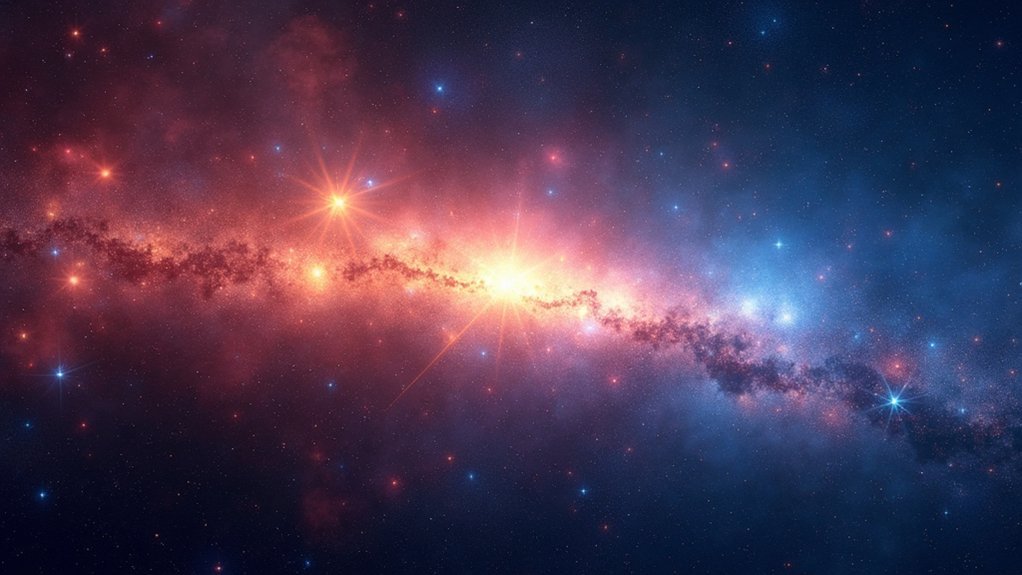
When you look at the night sky, you’re witnessing a temperature map of the cosmos displayed through color. The hues you observe directly reveal each star’s surface temperature, following a predictable pattern across the universe.
The coolest stars shine in red, with surface temperatures around 3,000ºC, while the hottest burn blue at up to 40,000ºC. Between these extremes, stars shift through a spectrum of orange, yellow, and white as they grow progressively hotter.
Astronomers classify stars using the sequence O, B, A, F, G, K, M—from hottest to coolest. Our Sun falls in the G category with a surface temperature of approximately 5,500ºC, appearing yellowish to our eyes.
This color-temperature relationship occurs because hotter stars emit light at shorter wavelengths, while cooler stars emit at longer wavelengths.
From Red Dwarfs to Blue Giants: The Stellar Spectrum
Across the vast expanse of our galaxy, stars populate a remarkable color spectrum that directly reflects their surface temperatures. At the coolest end, you’ll find abundant red dwarfs, M-type stars with temperatures between 2,100-3,400°C. These long-lived stars emit light at longer wavelengths, giving them their characteristic reddish hue.
Our Sun sits in the middle as a G-type star with a surface temperature of about 5,500°C, appearing yellowish from Earth.
As a star’s temperature increases, its color shifts toward the blue end of the spectrum. The hottest stars—O-type giants like Rigel and Deneb—burn at over 30,000°C and shine with a brilliant blue light at shorter wavelengths.
This temperature-dependent coloration also reveals a star’s evolutionary stage, as massive stars evolve from blue to red as they age.
How Our Eyes Perceive Starlight
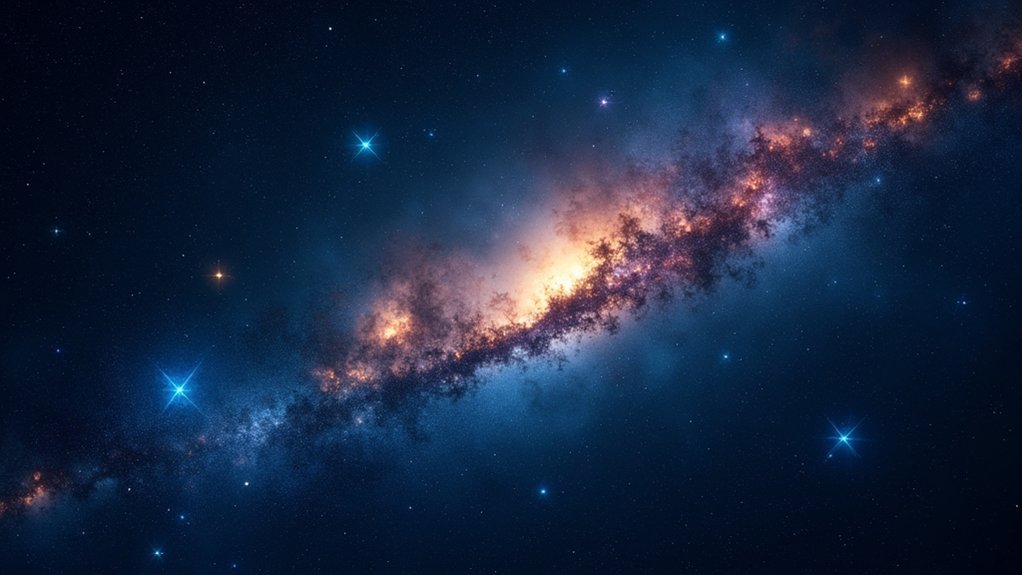
Despite the colorful array of stars dotting our night sky, you’ll notice that most appear as mere white pinpoints of light. This occurs because your eyes contain two types of photoreceptors: rods and cones. In darkness, your cones (which detect colors of stars) deactivate while rods (which only see in grayscale) take over.
| Viewing Condition | Color Perception | Star Appearance |
|---|---|---|
| Bright Stars | Good | Colorful |
| Faint Stars | Poor | Whitish |
| Urban Areas | Limited | Fewer colors |
| Dark Sky Sites | Enhanced | More vivid hues |
You’ll see more colors by using optical aids like binoculars or telescopes, which gather enough light to activate your cones. The brightest stars—like reddish Betelgeuse or bluish Rigel—will show their true colors even to the naked eye.
Star Classification Systems Through History
While your eyes perceive stars in different hues based on viewing conditions, humans have long sought to systematically categorize these celestial bodies. As far back as the Iron Age, astronomers recognized that star colors corresponded to temperature—blue stars burn hotter while red stars remain cooler. This understanding was often illustrated using the analogy of heating an iron bar.
From ancient times, we’ve understood that a star’s color reveals its temperature, just as metal glows from red to blue when heated.
The 19th century brought revolutionary changes with the advent of spectroscopy, allowing astronomers to analyze starlight’s composition in unprecedented detail.
Annie Jump Cannon transformed star classification systems in the early 20th century by developing a sequence from O to M, organizing stars from hottest to coolest based on their spectra.
Today’s classification extends beyond Cannon’s work to include even cooler stellar types labeled L, T, and Y—expanding our understanding of the diverse stellar population.
Decoding the OBAFGKM Stellar Classification
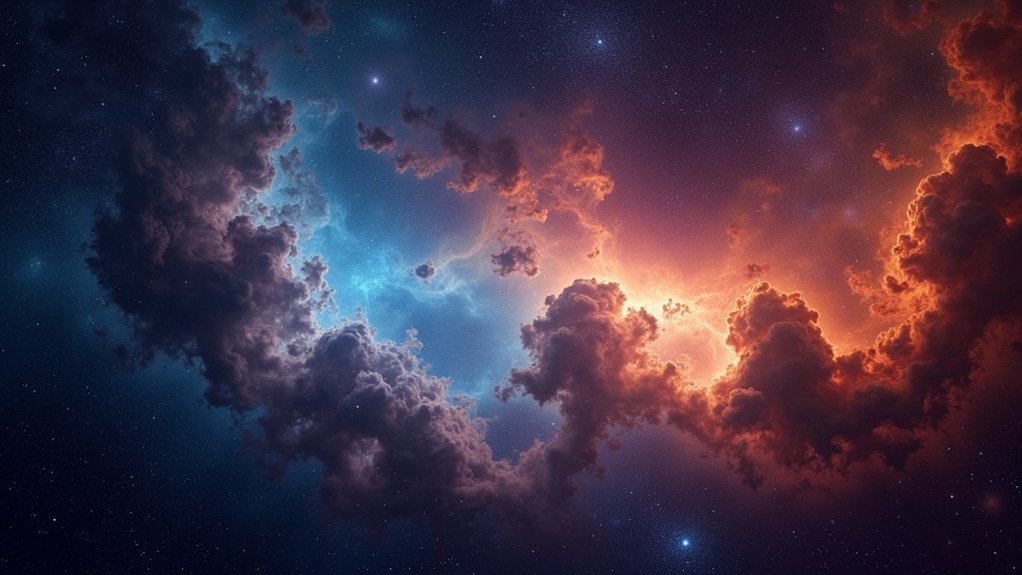
The famous mnemonic “Oh Be A Fine Girl/Guy, Kiss Me” helps astronomers remember the sequence of stellar classes that forms the backbone of modern star classification. This OBAFGKM system, developed with significant contributions from Annie Jump Cannon in the early 20th century, arranges stars from hottest to coolest based on their surface temperatures.
When you observe stars of different colors in the night sky, you’re witnessing temperature variations across the spectrum. O-type stars burn blazingly hot at over 100,000°C with a distinctive blue appearance, while cool M-type stars glow red at 2,100-3,400°C.
Between these extremes, you’ll find our Sun, a G-type star with a surface temperature between 4,900-5,700°C. This classification system allows astronomers to quickly identify stellar properties just by observing a star’s color.
Why Most Stars Appear White to the Naked Eye
When you gaze at the night sky, most stars appear white because their faint light can’t activate the color-sensitive cones in your eyes, triggering only the brightness-detecting rods instead.
Your visual system requires a certain threshold of light intensity to perceive colors, which many distant stars simply don’t provide.
You’ll notice that only the brightest stars, like ruddy Betelgeuse or bluish Rigel, emit enough light to cross this threshold and reveal their true colors to your naked eye.
Vision Limitations
Have you ever wondered why most stars in the night sky appear white despite their actual diverse colors? The answer lies in the limitations of your naked eye.
Your vision has two types of photoreceptors: rods and cones. While cones perceive color, they require sufficient light to activate—something most distant stars fail to provide.
In low-light conditions, your eyes primarily rely on rod cells, which detect brightness but not color. Only the brightest stars emit enough light to trigger your cone cells, allowing you to perceive their true colors.
As daylight fades into dusk, you’ll notice colors gradually disappearing from your surroundings—the same phenomenon affects your perception of stars. Light pollution in urban areas further washes out these subtle stellar hues, rendering even more stars as simple white dots.
Rod-Cone Activation
Understanding how our eyes process starlight reveals why most celestial objects appear as white pinpoints. This phenomenon results from rod-cone activation patterns in your retina when observing the night sky.
Your eyes contain two types of photoreceptors: rods for low-light vision and cones for color detection. During twilight or nighttime viewing, most stars don’t emit enough light to activate your color-sensitive cones, leaving only the monochromatic rods functioning. This biological limitation explains why fainter stars appear white despite having actual colors.
Only the brightest stars—like ruddy Betelgeuse or bluish Rigel—provide sufficient illumination to trigger your cone cells.
Environmental factors compound this effect; in dark-sky locations, you’ll notice more star colors as your eyes adapt fully to darkness, optimizing the rod-cone activation process.
Light Intensity Thresholds
Though stars shine in various colors across the spectrum, your eyes require a minimum light intensity to perceive these hues accurately.
When you gaze at the night sky, most stars appear white because their light is too faint to activate your color-detecting cone cells. Your vision shifts to rod-dominated mode in low light, sacrificing color for sensitivity.
Here’s why you’ll typically see white instead of true stellar colors:
- Brightness threshold: Only the brightest stars emit enough light to trigger your cone cells.
- Fading at dusk: As daylight diminishes, your color perception decreases.
- Urban interference: Light pollution washes out subtle star colors.
- Optical assistance: Using telescopes or binoculars concentrates light, helping you see colors that naked eyes miss.
Seasonal Stargazing: Best Times to Observe Colored Stars
While many stargazers enjoy the night sky year-round, winter months offer the most spectacular opportunities to witness stars in their true colors. The clearer winter skies enhance visibility, highlighting bright stars with distinctive color tints that might appear muted in hazier conditions.
You’ll find seasonal variations in star visibility throughout the year. Stars like Arcturus and Vega become more prominent during specific seasons, making them easier to identify and observe.
For ideal viewing, seek locations with minimal light pollution such as Dunkery Beacon, where artificial lighting won’t interfere with the stars’ natural hues.
Don’t forget your equipment – even a basic pair of binoculars will greatly improve your ability to detect the subtle coloration of fainter stars that your naked eye might miss.
Light Pollution’s Impact on Stellar Color Perception
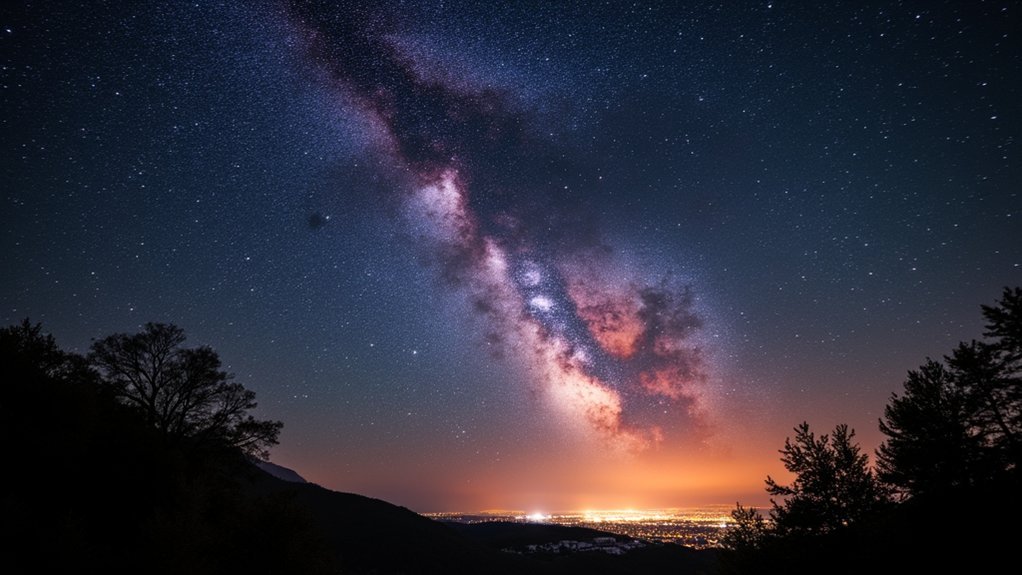
You’ll notice that stars lose their vivid colors when viewed from light-polluted urban areas, as artificial illumination overwhelms their subtle hues and renders even distinctly colored stars a bland white.
This “sky whitewashing” effect progressively worsens with increased urban lighting, making it impossible to discern the true colors of all but the brightest stars.
Moving to darker locations or using optical aids like binoculars can dramatically improve your ability to perceive stellar colors by restoring the natural contrast between stars and the night sky.
Light Pollution’s Impact on Stellar Color Perception
Despite our best efforts to observe the night sky, light pollution has become a major obstacle in perceiving the true colors of stars. When artificial light washes out the darkness, it reduces the contrast between stars and the background sky, causing most stars to appear white rather than displaying their natural hues.
To understand how light pollution affects your stargazing experience:
- Urban environments limit visibility to only the brightest stars, masking the colorful diversity of fainter celestial objects.
- The glow from streetlights creates a sky background that diminishes color perception.
- Moving to darker locations away from cities dramatically improves your ability to see stellar colors.
- Using optical aids like telescopes or binoculars can help overcome some effects of light pollution by magnifying stellar light.
Urban Sky Whitewashing
As artificial lighting bathes our cities in perpetual twilight, the delicate colors of stars vanish into a homogenous white glow overhead. This phenomenon, known as urban sky whitewashing, robs you of the rich chromatic tapestry that exists beyond our atmosphere.
The broad-spectrum emissions from streetlights create a luminous haze that dramatically reduces contrast in the night sky. What you’re seeing isn’t the true celestial display, but rather a washed-out version where subtle color differences between stars become indistinguishable.
To experience the authentic palette of stellar colors, you’ll need to venture away from city limits. During winter months, when skies are naturally darker and clearer, you can better appreciate the varied hues.
For ideal viewing, bring binoculars or a telescope to dark-sky locations.
Using Binoculars and Telescopes to Enhance Color Visibility
While the naked eye can detect colors in brighter stars, optical aids dramatically improve your ability to perceive the subtle hues of celestial objects.
Binoculars or a telescope collect more light than your eyes alone, revealing delicate color distinctions that remain hidden to unaided vision.
For the best color-viewing experience:
- Try de-focusing your telescope slightly to create a colored disc effect, making star colors more apparent
- Observe during winter months when atmospheric conditions often provide clearer skies
- Use your optical aids in locations with minimal light pollution for maximum contrast
- Experiment with different magnifications—sometimes lower power views reveal colors better by gathering more light
These techniques will transform your stargazing from seeing mere points of light to appreciating the vibrant cosmic palette above.
The Physics Behind Star Color and Brightness
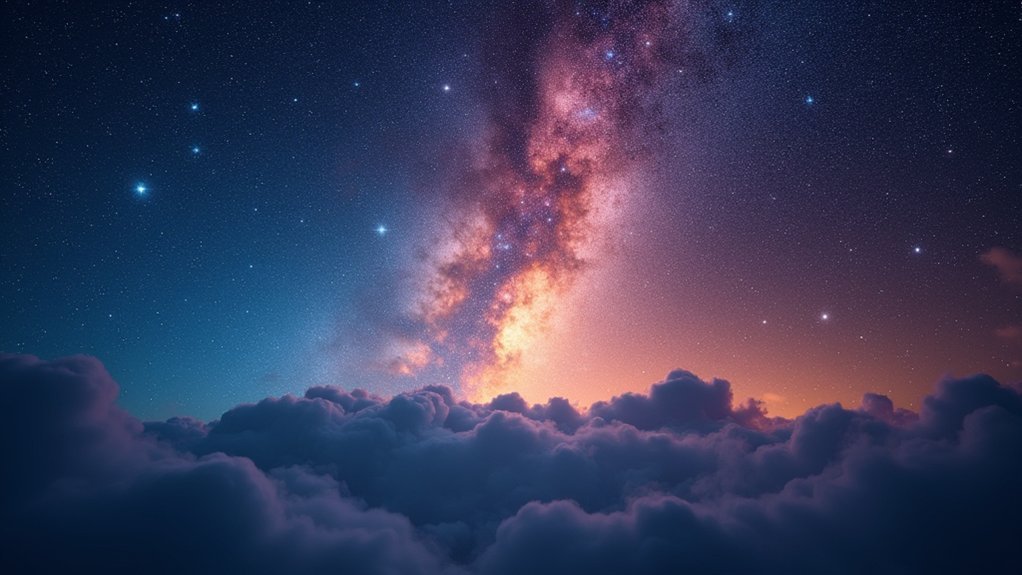
When you gaze at the night sky, the dazzling array of celestial colors reveals fundamental physics at work. Stars emit light based on their surface temperatures, following a principle called blackbody radiation. Hotter stars radiate more energy at shorter wavelengths (blue), while cooler stars emit at longer wavelengths (red).
| Stellar Class | Surface Temperature | Color | Examples | Relative Brightness |
|---|---|---|---|---|
| O | 30,000-40,000°C | Blue | Zeta Puppis | 1,400,000× Sun |
| B | 10,000-30,000°C | Blue-white | Rigel | 12,000× Sun |
| G | 5,200-6,000°C | Yellow | Sun | 1× Sun |
| K | 3,700-5,200°C | Orange | Arcturus | 0.4× Sun |
| M | 2,400-3,700°C | Red | Betelgeuse | 0.04× Sun |
The stellar classification system (O, B, A, F, G, K, M, L, T, Y) arranges stars from hottest to coolest, giving astronomers a standardized way to categorize the universe’s light sources.
Famous Colored Stars to Spot in the Night Sky
The night sky transforms into a celestial color palette once you know where to look. Among the thousands of bright stars visible to the naked eye, several stand out with their distinctive colors, revealing their temperature and composition.
- Vega – This brilliant blue star in Lyra shines at a scorching 9,600°C, making it one of the hottest stars you can easily spot.
- Arcturus – Look for this orange jewel in Boötes, cooler at 4,300°C but unmistakable for its warm glow.
- Antares – The red supergiant in Scorpius displays a remarkable reddish hue at just 3,500°C.
- Sirius – The brightest star in our night sky appears white-blue with Sirius A burning at nearly 10,000°C, while Fomalhaut offers a subtle blue tint visible even without equipment.
Dark Adaptation Techniques for Better Star Color Observation
Spotting these colorful celestial bodies requires more than just knowing where to look—your eyes need proper preparation to fully appreciate the subtle hues of stars.
For ideal dark adaptation techniques for better star color observation, spend at least an hour in darkness. This maximizes your rod and cone function, enhancing your ability to detect subtle stellar colors.
When maneuvering during stargazing sessions, use a red light torch. This preserves your night vision while allowing safe movement in the dark.
Choose locations with minimal light pollution, like Dunkery Beacon, to see stars’ true colors.
For even better results, try optical aids. Binoculars gather more light than your naked eye, revealing color distinctions in fainter stars.
With telescopes, you can even try de-focusing slightly to create colored discs, making stellar hues more apparent.
Frequently Asked Questions
What Is the Rarest Color of Star?
Blue-violet is the rarest star color you’ll find. These O-type stars burn extremely hot (over 30,000ºC) and massive, making them short-lived as they quickly consume their fuel before exploding as supernovae.
What Is the Star That Shines Different Colors?
You’re probably thinking of Sirius, which appears to twinkle in different colors when low on the horizon. This effect isn’t the star itself changing, but Earth’s atmosphere distorting its light.
What Does the Color of a Shining Star Indicate?
When you observe a star’s color, you’re seeing its surface temperature. Hotter stars shine blue (up to 40,000°C), while cooler stars appear red (around 3,000°C). It’s a direct indicator of stellar temperature.
Why Do Some Stars Appear Blue and Some Stars Appear Red?
You’ll see stars appear blue when they’re hotter (over 10,000ºC) and red when they’re cooler (around 3,000ºC). This temperature difference affects their emission wavelengths—blue stars emit shorter wavelengths, red stars longer ones.
In Summary
You’ve journeyed across the spectrum of stellar colors, from cool red dwarfs to scorching blue giants. Now when you gaze skyward, you’ll understand that a star’s color reveals its temperature, age, and composition. With your new knowledge of stellar classification and observation techniques, you’ve gained deeper insight into these distant suns, transforming your nighttime stargazing into a richer, more colorful experience.




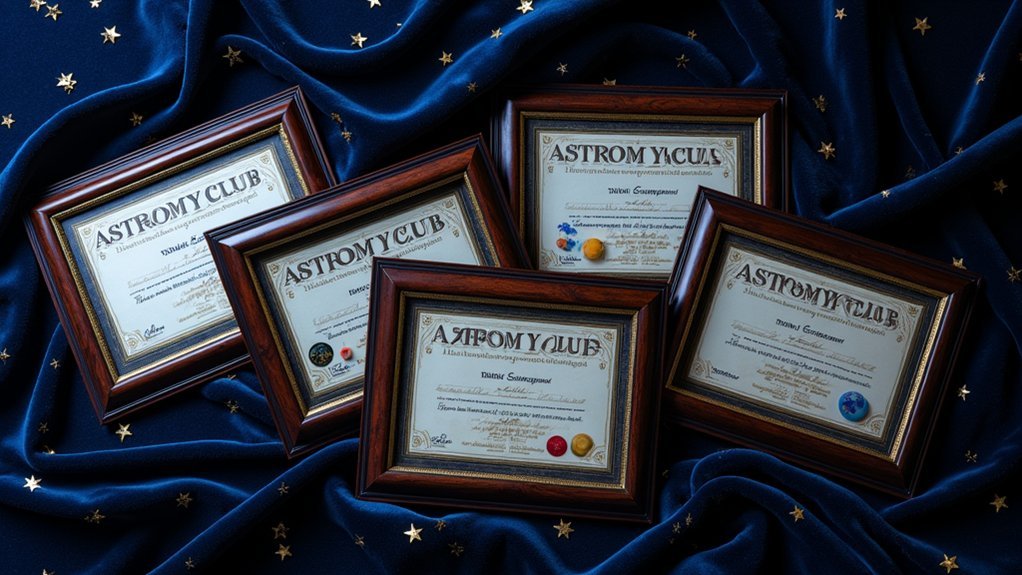
Leave a Reply